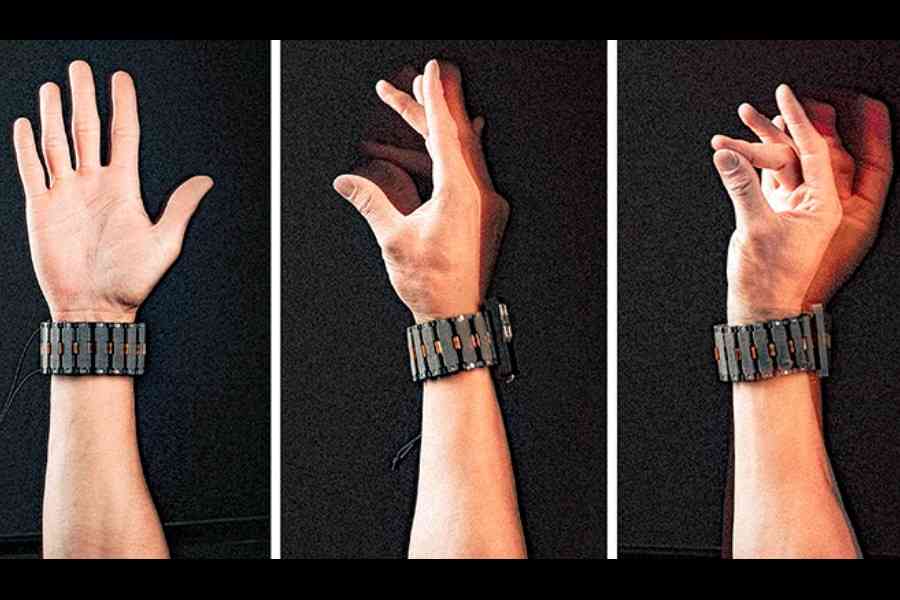The prototype looks like a giant rectangular wristwatch. But it doesn’t tell the time: it lets you control a computer from across the room by moving your hand. With a gentle turn of the wrist, you can push a cursor across your laptop screen.
If you tap your thumb against your forefinger, you can open an app. And when you write your name in the air, the letters will appear on your smartphone. Designed by researchers at Meta, the tech giant that owns Facebook, Instagram and WhatsApp, this experimental technology reads the electrical signals that pulse through your muscles when you move your fingers.
These signals, generated by commands from your brain, can reveal what you are about to do even before you do it. With a little practice, you can move your laptop cursor simply by producing the right thought.
“You don’t have to actually move,” Thomas Reardon, the Meta vice-president of research who leads the project, said.
“You just have to intend the move.” Meta’s wristband uses a technique called electromyography, or EMG, to gather electrical signals from muscles in the forearm.
These signals are produced by neurons in the spinal cord — called alpha motor neurons — that connect to individual muscle fibres. Because these neurons connect directly to muscle fibres, the electrical signals are strong — so strong that they can be read from outside the skin.
EMG has long provided a way for amputees to control prosthetic hands. But technologies that use the technique as a computer interface are only beginning to mature. In 2012, three Canadian entrepreneurs founded a company called Thalmic Labs, which built an armband called Myo that sent simple computer commands using hand gestures. With the swipe of a hand, for instance, you could switch to a new slide in a PowerPoint presentation.
But the company discontinued the product. Reardon started similar research after founding a company called Ctrl Labs with two other neuroscientists he had met in a PhD programme at Columbia University, US.
In 2019, the startup was acquired by Meta, where it now operates within a research operation called Reality Labs. Although Reardon and his colleagues have been privately demonstrating their technology for years, they are only now beginning to publicly share their work because it is now mature enough for the marketplace.
The key development is the use of AI techniques to analyse the EMG signals. After collecting these signals from 10,000 people who agreed to test the prototype, Reardon used a machine learning system called a neural network to identify common patterns in this data. Now, it can look for these same patterns even when a different person is using the device.
“Out of the box, it can work with a new user it has never seen data for,” said Patrick Kaifosh, director of research science at Reality Labs and one of the founders of Ctrl Labs.
According to Reardon, who is also known as the founding father of the Internet Explorer web browser, Meta plans to fold the technology into products over the next few years.
Last fall, the company demonstrated how its wristband could be used to control an experimental version of its smart glasses, which can take photos, record videos, play music and verbally describe the world around you.
Meta’s wristband could also provide new options for disabled people. Researchers at Carnegie Mellon are testing the wristband with people who have spinal cord injuries, allowing them to use smartphones and computers even though they do not have full use of their arms or hands.
Most people with these types of injuries retain the ability to activate at least some of their muscle fibres. This allows the device to read what their brain is trying to do, even though their bodies can not actually make it happen.
“We can see their intention to type,” said Douglas Weber, a professor of mechanical engineering and neuroscience at Carnegie Mellon.
In a similar way, Meta’s wristband lets you control a computer with the appropriate thought. Merely thinking about a movement is not enough.
But if you intend to make a movement, the wristband can pick up on what you aim to do — even if you do not physically move. “It feels like the device is reading your mind, but it is not,” Reardon said. “It is just translating your intention. It sees what you are about to do.”
nytns










